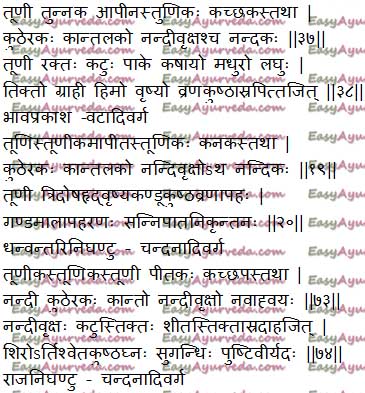Red Cedar (Toona) – Uses, Remedies, Dose, Research, Side Effects
By Dr Renita D’Souza
Toona (Cedrela toona) is an Ayurvedic medicinal herb commonly known as Red cedar. It is traditionally used to treat diarrhoea, dysentery, wounds, skin diseases, bleeding disorders, menstrual disorders etc. It is also acts as cardiac tonic and aphrodisiac.
Table of Contents
Introduction
Botanical Name – Cedrela toona
Synonyms – Toona ciliata
Family – Meliaceae
Sanskrit Synonyms
Tooni, Tunnaka, Aapin,
Tunika, Kachaka, Kuteraka
Kantalaka, Nandivrksha, Nandaka
Nandika
Medicinal Qualities of Toon
Taste – Astringent (kashaya), Sweet (madhura), Bitter (tiktha)
Vipaka (taste after digestion) – Pungent (katu)
Virya (potency) – cold (shitha)
Qualities
Laghu – light for digestion
Grahi – Absorbent
Vrishya – aphrodisiac
Pustiviryada – improves strength and immunity
Traditional Uses of Toona
Vrana – wounds, ulcers
Kusta – skin diseases
Raktapitta – bleeding disorders
Hear diseases
Kandu – Itching
Gandamala – Cervical adenitis
Blood disorders
Daha – burning sensation
Shiroarti – Headache
Shwetha kusta – vitiligo
Effect on Tridoshas
Balances all three doshas, Vata, Pitta and Kapha dosha.
Morphology of Cedrela toona
Cedrela toona is tree growing up to 20 – 30 meter in height. Leaves pinnate, alternate, leaflets 5-12 pairs, 4 – 13 cm long, glabrous, oblong-lanceolate. Flowers are small, fragrant, white in colour, in a large pyramidal panicle at the ends of branchlets. Fruit capsules, 5-valved, possess 25 – 30 seeds, 2 cm long, oblong, thin-winged at both ends. Heartwood is reddish in colour.
Traditional Remedies of Toona
- Bark infusion or decoction is used in children for diarrhoea caused due to indigestion.
- Infusion of flowers or bark of tooni plant is used in excess menstrual bleeding.
- Bark paste or powder is applied over wound for fast healing.
- Dried leaf powder with salt and water is used in the treatment of diabetes, skin allergy and wounds. It acts as a blood purifier.
- Gum obtained from the bark is used in fever.
- Flower decotion is used in menstrual disorders and stimulates menstrual bleeding. It acts as a powerful emmenagogue.

Dose
Decoction – 25 – 30 ml
Side Effects of Tuni
There are no recorded side effects.
However, high oral dosage can cause constipation due to its astringent property.
External application can sometimes produce skin irritation.
Interaction with medicines, supplements
Can this be used while taking Homeopathic medicine?
Yes. This product does not react with homeopathic medicine.
Can
this medicine be continued while taking supplements like multivitamin tablets,
Omega 3 fatty acids etc?
Yes. Generally, this product goes well with most
of the dietary supplements. However, if you are taking more than one product
per day, please consult your doctor for an opinion.
With western
medicines
Seek your
doctor’s advice if you are taking this product along with other western
(allopathic / modern) medicines. Some Ayurvedic herbs can interact with modern
medicine.
If both Ayurvedic and allopathic medicines are advised together, then it is
best to take Allopathic medicine first, wait for 30 minutes and then take the
Ayurvedic medicine.
Phytoconstituents
Toona ciliata contains triterpenoids, cedrelone, polyynes, limonoids, siderin, steroids etc.
Pharmacological Activities
Toona ciliata possess antidiabetic activity, anti-ulcer activity, anti-oxidant activity, anti-inflammatory activity, antimicrobial activity, antifungal activity.
Names in different Languages
English Name – Toon, Red cedar, Indian Mahagony
Hindi Name – Toon, Tun, Tooni, Mahanim
Bengali Name – Toongaacha, Tun
Marathi Name – Tooni, Koorak, Kunant
Gujarati Name – Tooni
Tamil Name – Toonmaram
Telugu Name – Nandi Vrikshamu, Nandichettu
Kannada Name – Biligandhagiri, Tundu
Manipuri Name – Tairel
Malayalam Name – Vempu, Thunnam, Ikana, Arana
Assamese Name – Poma Jatipoma
Distribution, research, category
Distribution
Toona ciliata is found in Bangladesh, Cambodia, China, India, Indonesia, Laos, Malaysia, Myanmar, Nepal, Pakistan, Papua New Guinea, Philippines, Thailand, Vietnam
Research
A review article on pharmacological activities of Toona ciliata (A, B)
Classical categorisation
Bhavaprakasha Nighantu – Vatadi varga
Dhanvantari Nighantu – Chandanadi varga
Raja Nighantu – Chandanadi Varga
Click to Consult Dr Renita D’Souza









